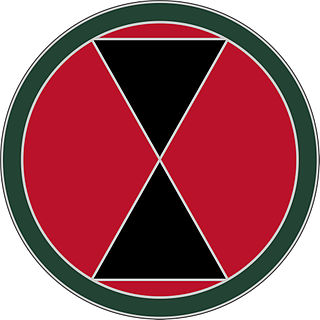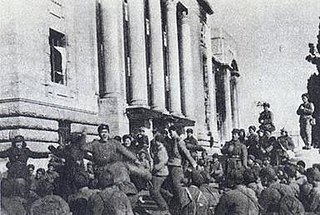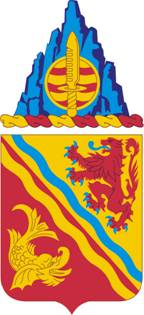
The 2nd Infantry Division is a formation of the United States Army. Its current primary mission is the pre-emptive defense of South Korea in the event of an invasion from North Korea. There are approximately 17,000 soldiers in the 2nd Infantry Division, with 10,000 of them stationed in South Korea, accounting for about 35% of the United States Forces Korea personnel.

The 7th Infantry Division is an active duty infantry division of the United States Army based at Joint Base Lewis-McChord charged with sustaining the combat readiness of two Stryker brigade combat teams, a combat aviation brigade, a division artillery headquarters, and a national guard Stryker brigade combat team, as well as participating in several yearly partnered exercises and operations in support of U.S. Army Pacific and the Indo-Pacific region. The 7th Infantry Division is the only active-duty multi-component division headquarters in the Army. The 7th Infantry Division is also home to two of the Army's newest enabling battlefield capabilities, the Multi Domain Task Force and the Intelligence, Information, Cyber, Electronic Warfare and Space Capabilities, or I2CEWS battalion.

The 25th Infantry Division is a United States Army division based at Schofield Barracks in Hawaii. The division, which was activated on 1 October 1941 in Hawaii, conducts military operations primarily in the Asia-Pacific region. Its present deployment is composed of Stryker, light infantry, airborne, and aviation units.

The Eighth Army a U.S. field army which is the commanding formation of all United States Army forces in South Korea. It commands U.S. and South Korean units and is headquartered at the United States Army Garrison-Humphreys, in the Anjeong-ri of Pyeongtaek, South Korea. It is the only field army in the U.S. Army
The Republic of Korea Presidential Unit Citation is a military unit award of the government of South Korea that may be presented to South Korean military units, and foreign military units for outstanding performance in defense of the Republic of Korea. In recognition of allied military service to South Korea during the Korean War, all United States military departments were authorized the unit award for that period.
The 27th Infantry Brigade was an infantry brigade of the British Army that saw service in the First World War, the Second World War, and the Korean War. In Korea, the brigade was known as 27th British Commonwealth Brigade due to the addition of Canadian, Australian, New Zealand and Indian units.

The 501st Military Intelligence Brigade is a United States Army formation, assigned to the United States Army Intelligence and Security Command (INSCOM) under the operational control of United States Forces Korea(USFK) located in South Korea. The 501st MI Brigade conducts theater level multi-discipline intelligence collection and analysis, aerial Intelligence Surveillance & Reconnaissance (ISR), and security operations in support of Eighth United States Army, U.S. Army Pacific, U.S. Pacific Command, U.S. Forces Korea, and other national level agencies.

The 8th Mechanized Infantry Division is a military formation of the South Korean army.

The Capital Mechanized Infantry Division, also known as Fierce Tiger Division, is currently one of the six mechanized infantry divisions in the Republic of Korea Army. It is part of the VII Corps, 3rd ROK Army (TROKA), tasked with covering approaches to Seoul from North Korea and counterattack operations.

The 6th Infantry Division was a military formation of the Republic of Korea Army during the 20th Century.

The 3rd Infantry Division is a unit of the Republic of Korea Army.
The 6th Infantry Division is a military formation of the Korean People's Army Ground Force.
The 32nd Infantry Regiment is a battalion within the United States Army. Of the original regiment, only the 1st Battalion remains as an active duty unit. The 1st Battalion, 32nd Infantry Regiment is a light infantry battalion assigned to the 1st Brigade Combat Team, 10th Mountain Division, garrisoned at Fort Drum, New York. The battalion was previously assigned to the 3rd Brigade Combat Team at Fort Drum, before this unit was reflagged to Fort Polk, Louisiana.
The 25th Canadian Infantry Brigade was Canada's primary combat-formation intending to be sent as part of the British Commonwealth Forces Korea. Originally composed of three infantry battalions and two armoured squadrons, several individual units rotated through the brigade. Although a full brigade had been trained and armed by 1951, the success of the Inchon Landing meant that only 2nd Battalion, Princess Patricia's Canadian Light Infantry (2PPCLI) was initially sent. However, Chinese and North Korean forces subjected Canadian forces to fierce fighting throughout April 1951. 2PPCLI earned a Presidential Unit Citation for their actions during the Battle of Kapyong while serving with the 27th Commonwealth Brigade. It had detached from the 25th Brigade in order to leave for Korea in advance of the formation, and would later rejoin its Canadian brigade group.

The Second Battle of Seoul was a battle that resulted in United Nations forces recapturing Seoul from the North Koreans in late September 1950.

The Third Battle of Seoul, also known as the Chinese New Year's Offensive, the January–Fourth Retreat or the Third Phase Campaign Western Sector, was a battle of the Korean War, which took place from December 31, 1950, to January 7, 1951, around the South Korean capital of Seoul. In the aftermath of the major Chinese People's Volunteer Army (PVA) victory at the Battle of the Ch'ongch'on River, the United Nations Command (UN) started to contemplate the possibility of evacuation from the Korean Peninsula. China's Chairman Mao Zedong ordered the Chinese People's Volunteer Army to cross the 38th Parallel in an effort to pressure the UN forces to withdraw from South Korea.

The 37th Field Artillery Regiment is a field artillery regiment of the United States Army, and parent regiment under the U.S. Army Regimental System. The regiment was first constituted 5 July 1918 in the National Army. The regiment served with the 10th Division during World War I, and the 2nd Infantry Division during World War II. Elements of the regiment have served with the 2nd Infantry Division, 6th Infantry Division, 79th Infantry Division, and 172nd Infantry Brigade, among other units. Two battalions of the regiment are currently active, the 1st Battalion, 37th Field Artillery is the 155mm towed cannon battalion assigned to the 1st Stryker Brigade Combat Team, 2nd Infantry Division and the 6th Battalion, 37th Field Artillery is a Multiple Launch Rocket System battalion in the 210th Field Artillery Brigade.

Operation Thunderbolt, also known in China as the Defensive Battle of the Han River Southern Bank, was a US offensive during the Korean War.















